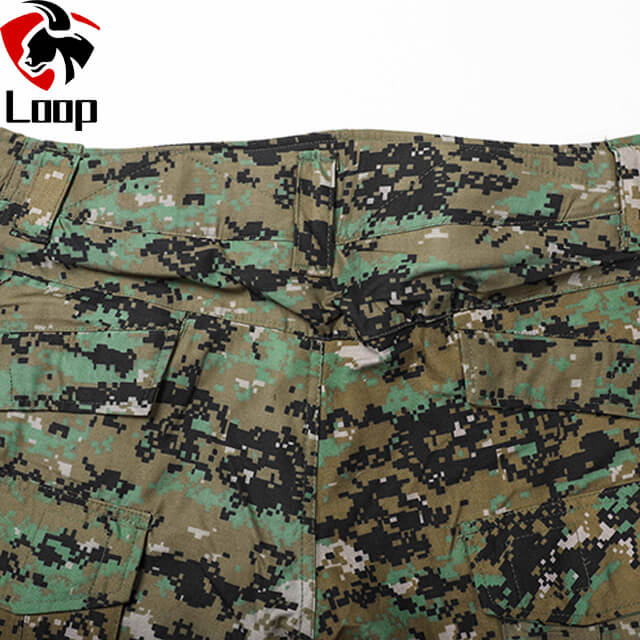Views: 0 Author: Site Editor Publish Time: 2025-10-10 Origin: Site











Introduction
Tactical pants are high-performance trousers designed for military personnel, law enforcement officers, security teams, and outdoor workers. Their core value lies in providing comfort, flexibility, and durability in extreme conditions while supporting equipment carrying and quick reactions. One of the key factors that determine their performance is fabric selection and structural design. Different materials mean different levels of protection, breathability, and tactical performance. This guide provides a full overview of common materials, structural techniques, functional features, and application scenarios to help you understand why tactical pants are an essential part of tactical gear.
Tactical pants fabrics usually emphasize "high strength, high durability, fast-drying, and lightweight". Manufacturers often use fiber blends or special weaving methods to achieve this balance.

Characteristics: Natural fibers, soft, breathable, and comfortable.
Advantages: Suitable for long wear, good moisture absorption, ideal for hot environments or daily duty.
Disadvantages: Moderate durability, slower drying when wet, slightly heavier.
Usage: Common in training or low-intensity task environments.
Improvement: Blending with polyester or nylon enhances durability and quick-drying.
Characteristics: Synthetic fiber, high strength, retains shape, quick-drying, wrinkle-resistant.
Advantages: Quick-drying, suitable for humid or rainy environments, good UV resistance.
Disadvantages: Slightly lower breathability and comfort.
Usage: Long outdoor activities or tropical operations.
Characteristics: High wear and tear resistance, core material for premium tactical pants.
Advantages: Lightweight, strong, oil-resistant, chemical-resistant.
Disadvantages: Low moisture absorption, melts under fire.
Usage: Used in SWAT, military tactical pants, and climbing operation pants.
Advanced versions: 500D or 1000D nylon fabrics with excellent protection.
Characteristics: High-strength nylon brand developed by DuPont, woven with anti-tear methods and special coating.
Advantages: Outstanding abrasion and tear resistance, stain-resistant, waterproof, much longer lifespan than standard nylon.
Usage: Used in premium tactical pants, vests, and tactical packs, standard in military and professional markets.
Tactical significance: Ensures durability in rugged terrains or high-friction environments; ideal for heavy-duty combat pants.
Principle: Thick fibers are woven into the fabric in a grid pattern to prevent tear expansion.
Advantages: Even if cut, tears do not spread easily.
Usage: Common in military uniforms, SWAT pants, jungle or reconnaissance pants.
Appearance: Visible micro-grid, combining light weight with toughness.
Characteristics: 2–5% elastane blended in main fabric for elasticity and recovery.
Advantages: Flexible and comfortable, supports a full range of motion; ideal for high-mobility tasks.
Usage: Modern tactical pants often include stretch fibers to enhance mobility.
Advanced application: 4-way stretch fabrics allow movement in all directions.
DWR (Durable Water Repellent): Repels water and prevents absorption.
Flame-retardant: Suitable for oil, chemical, firefighting, and demolition environments.
Anti-static coating: Prevents sparks from static electricity.
Anti-bacterial treatment: Reduces odor and bacterial growth from sweat.
Infrared-reduced coating (IRR): Reduces detection under night-vision devices.
Weave type and fabric weight (gsm) greatly influence overall performance.
Plain weave: Lightweight and breathable, suitable for hot climates.
Twill weave: Dense, thicker feel, higher abrasion resistance.
Oxford weave: Stable, durable, often used for reinforced legs and knees.
Ripstop: Combines light weight and tear resistance, mainstream for tactical pants.
Fabric weight classifications:
150–220 g/m²: Lightweight, quick-drying pants, flexible and breathable.
220–320 g/m²: Standard tactical pants, balance between durability and comfort.
320 g/m²+: Heavy-duty mission pants, suitable for harsh outdoor or construction environments.
Knee areas are often double-layered or reinforced with anti-tear fabric. Some models have internal knee pockets to insert EVA or TPU pads for protection during crawling or aggressive movements.
Triangle gusset design prevents tearing and increases freedom of movement, ideal for tactical, climbing, or high-mobility operations.
High-stress areas like knees, pockets, belt loops, and seat use triple stitching to ensure durability under heavy use.
Typically 6–12 pockets, including magazine, tool, knife, and phone pockets, ergonomically placed for quick access.
Widened belt loops, tactical waistbands, or internal adjustment straps support tactical belts, holsters, or MOLLE systems.
Leg cuffs use Velcro or drawstrings to fit with boots, preventing debris entry and maintaining mobility.
Equipment carrying: Multi-pocket design reduces external load and increases mobility.
Concealment: Color, camouflage, and IRR coatings reduce detectability.
Protection: High-strength nylon and reinforced construction minimize injuries.
Environmental adaptability: Waterproof, stain-resistant, quick-drying, heat-resistant.
Mobility: Stretch fabric and gusseted design support complex movements and improve performance.
SWAT or law enforcement: nylon + stretch (Ripstop) for mobility and abrasion resistance, often black or navy.
Military operations: CORDURA® high-strength nylon for maximum protection, tear resistance, and weather durability.
Outdoor survival/exploration: nylon + polyester blend with DWR coating for waterproof, quick-drying, and lightweight performance.
Security/guard: cotton-polyester blend, cost-effective, neat appearance, comfortable.
Urban commuting/daily wear: cotton + spandex, comfortable and breathable.
Washing: Avoid bleach and hot water; use gentle cycles.
Drying: Air-dry, avoid high heat that can damage coatings.
Waterproof coating maintenance: Reapply DWR sprays periodically.
Knee pads and accessories: Clean after use to prevent abrasion.
Storage: Avoid long-term compression or damp storage to prevent wrinkles or mildew.
Composite fibers and four-way stretch fabrics combine durability and comfort.
Waterproof and breathable membranes (ePTFE or TPU) for all-weather use.
Laser-cut and heat-pressed techniques reduce seams and increase strength.
Integration with MOLLE, D-Rings, and other modular tactical systems.
Hidden pockets and low-visibility designs for tactical and urban wear.
Tactical pants are evolving from professional gear to multifunctional apparel suitable for outdoor, security, and daily use.
The value of tactical pants extends beyond durability and protection; it reflects the pursuit of task efficiency, comfort, and survivability. Whether it is the hardcore protection of Cordura nylon or the flexibility of stretch blends, every material choice represents careful consideration of the user's operational environment and tactical requirements.
Choosing the right tactical pants means higher safety, stronger adaptability, and—when it matters most—the ability to hold on one more step.
Click here to view more Loop circle equipment
If you are looking for high-quality tactical accessories, ballistic helmet, ballistic plate, ballistic vest, or other Bulletproof-Shield, contact us today. We provide professional-grade solutions, competitive pricing, and fast delivery to build a reliable tactical system for your needs.